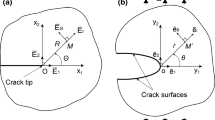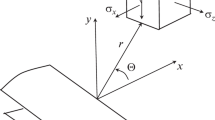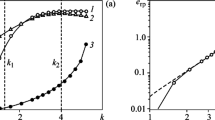Abstract
The study of the distribution of the elastic-strain energy density at the tip of a crack presents a special interest for the understanding of the mechanism of fracture. In this investigation an exhaustive theoretical analysis of the distribution of the elastic-strain energy density at the tip of a crack for cracks in isotropic elastic media deformed under modes I and II was developed.
This study was complemented by an experimental solution of this type of problem, based on the method of reflected caustics. According to this method the distribution of the elastic-strain energy density was evaluated along a circular closed curve, defining the singular core around the crack-tip, which was dominated by the singularity at the crack tip and whose diameter is very small, not exceeding a few millimeters. In this way the situation at the crack-tip singularity was directly depicted on the energy density distribution. Interesting results concerning the factors influencing the mode of the strain energy distribution around the crack and the type of the crack path were derived.
Résumé
L'étude de la distribution de la densité d'énergie de déformation élastique à l'extrémité d'une fissure présente une intéret particulier pour comprendre le mécanisme de la rupture. Dans cette étude, on a développé une analyse théorique exhaustive de la distribution de la densité d'énergie de déformation élastique à l'extrémité d'une fissure dans le cas de fissures situées dans un milieu élastique isotrope déformé selon les models I et II. Cette étude a été complétée par une solution expérimentale de ce type de problème basée sur la méthode des caustiques réfléchies. Selon cette méthode, la distribuiton de la densité d'énergie de déformation élastique est évaluée le long d'une courbe fermée circulaire définissant un noyau singulier autour de l'extrémité de la fissure qui est influencé par la singularité à l'extrémité de la fissure, et dont le diamètre est tres petit et n'excède pas quelques millimètres. Par cette voie, la situation à la singularité de lextrémité de la fissure a été dépeinte directement sur base de la distribution de densité d'énergie. Des résultats intéressants concernant les facteurs qui influencent le mode de distribution d'énergie de déformation au voisinage de la fissure ainsi que du type de chemin de fissuration ont pu être dérivés.
Similar content being viewed by others
References
G.C. Sih, International Journal of Fracture 10 No. 3 (1974) 305–321.
G.C. Sih, Journal of Engineering Fracture Mechanics 5 (1973) 365–377.
G.C. Sih, Application of the Strain-Energy-Density Theory to Fundamental Fracture Problems, Institute of Fracture and Solid Mechanics, Technical Report, Lehigh University (1972).
G.C. Sih, Introductory Chapter in Mechanics of Fracture 1, Noordhoff (1972).
J. Riedmüller, Experimentelle Bestimmung der Energiedichteverteilung in der Nähe von Risspitzen bei überlagerter Normal- und Scherbeanspruchung, Wissenschaftlicher Bericht, Institut für Festkörpermechanik der Fraunhofer-Gesellschaft e.v., Freiburg i. Br. (August 1975).
P.S. Theocaris, Applied Optics 10 No. 10 (1971) 2240–2247.
P.S. Theocaris and E. Gdoutos, Journal of Applied Mechanics (1972) 91–97.
P.S. Theocaris and C.I. Razem, International Journal of Mechanical Sciences (1981) to be published.
F. Erdogan and G.C. Sih, ASME Journal of Basic Engineering 85D (1963) 519–527.
G.C. Sih, Introductory Chapter in Mechanics of Fracture, 2, Noordhoff (1975).
A.A. Griffith, Philosophical Transactions of the Royal Society 221 Series A (1921) 163–198.
A.A. Griffith, The Theory of Rupture, Proceeding, First International Congress of Applied Mechanics, Delft (1924) 55–63.
J.G. Williams and P.D. Ewing, International Journal of Fracture Mechanics 8, No. 4 (1972) 441–446.
N.I. Muskhelishvili, Some Basic Problems of the Mathematical Theory of Elasticity, 4th Edn. Noordhoff, Groningen (1963).
J. Eftis and N. Subramonian, Engineering Fracture Mechanics 10 (1978) 43–67.
P.S. Theocaris and G.A. Papadopoulos, Materialprüfung 22, No. 6 (1980) 246–253.
A.P. Kfouri, International Journal of Fracture 15 No. 1 (1979) 23–29.
P.S. Theocaris and E.E. Gdoutos, Journal of Applied Mechanics 18 No. 1 (1976) 64–68.
G.J. Tsamasphyros et P.S. Theocaris, Journal de mécanique 15, No. 4 (1976) 615–630.
Author information
Authors and Affiliations
Rights and permissions
About this article
Cite this article
Theocaris, P.S., Papadopoulos, G. The distribution of the elastic strain-energy density at the crack tip for fracture modes I and II. Int J Fract 18, 81–112 (1982). https://doi.org/10.1007/BF00019635
Received:
Revised:
Issue Date:
DOI: https://doi.org/10.1007/BF00019635




